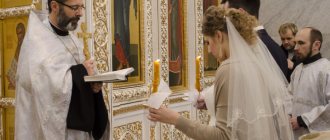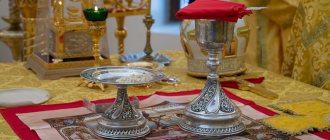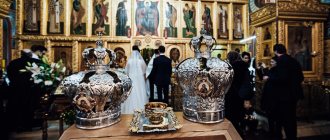When good children, setting out on some journey unknown to them, come to their mother and ask for her parting blessing, the tender mother, sincerely and lovingly blessing them, what kind of sincere feelings and heartfelt wishes she will not express to them!
The loving Church of Christ does the same when her obedient children - the bride and groom - come to the temple of God, asking for her maternal blessing on the path of married life unknown to them.
Church wedding. Photo - Lori's photo bank
God established marriage as a loving union between husband and wife for the continuation of the human race and the raising of children. As it is said in the book of Genesis, after the creation of Adam and Eve, God blessed them, and God said to them: “Be fruitful and multiply, and fill the earth and subdue it.”
The Savior sanctified the union of the bride and groom by His presence at the wedding in Cana of Galilee, where He performed His first miracle. Talking with the Pharisees tempting Him about marriage and divorce, the Lord said: “For this reason a man will leave his father and mother and be united to his wife, and the two will become one flesh, so that they are no longer two, but one flesh. Therefore, what God has joined together, let no man separate.”
In the Sacrament of Marriage, the Church blesses the bride and groom to live together, to give birth and raise children. The bride and groom must promise God that they will be faithful to each other throughout their lives. Of course, such a promise and the marriage itself should be free and relaxed.
In the Sacrament of Marriage, the grace of the Holy Spirit invisibly unites two separate human beings into a single spiritual whole. The grace of the Holy Spirit is in this Sacrament the force that binds a man and a woman into a qualitatively new spiritual union - a Christian family.
One of the Church Fathers in ancient times said that the world cannot exist without the sacraments, that is, without some states, some relationships being super-earthly, heavenly, miraculous; and - he continues - marriage as the unity of two in a disunited world is such a sacrament, a miracle, surpassing all natural mutual relationships, all natural states!
It is important to understand that in the union of a man and a woman, sanctified by the Sacrament of Marriage, the Grace of the Holy Spirit invisibly unites two separate human beings into a single spiritual whole, just as two separate substances, for example sand and cement, when united with the help of water, become qualitatively new, inseparable substance.
And just as water, in this example, is a binding force, so the Grace of the Holy Spirit is in the Sacrament of Marriage a force that binds a man and a woman into a qualitatively new, spiritual union - a Christian family.
Moreover, the purpose of this union is not only procreation and mutual assistance in everyday life, but mainly, joint spiritual improvement, multiplication of Grace, because the Christian family is the Little Church of Christ, Christian marriage is one of the forms of serving God.
How to prepare for a wedding
To perform a church marriage, you need to prepare two icons - the Savior and the Mother of God, with which the bride and groom are blessed during the Sacrament. Previously, these icons were passed down as home shrines from parents to children.
The bride and groom must purchase wedding rings. The ring is a sign of eternity and indissolubility of the marriage union. According to tradition, one of the rings should be gold and the other silver. The golden ring symbolizes with its brilliance the sun, to the light of which the husband in marriage is likened; silver is a semblance of the moon, a lesser luminary, shining with reflected sunlight, it is for the wife. Often today, gold rings are purchased for both spouses.
But still, the main preparation for the upcoming Sacrament is fasting. The Holy Church recommends that those entering the 6th century prepare themselves for the Sacrament through the feat of fasting and prayer, repentance and communion.
Tips for those getting married:
- In order for the Wedding to become a true holiday, memorable for a lifetime, you need to take care of its organization in advance. First of all, agree on the place and time of the Sacrament. In many churches there is a preliminary registration, when not only the day, but also the time of the wedding is indicated. Any relative can do it.
- In those churches where there is no such record, the newlyweds issue a receipt for the sacrament to be performed on their wedding day. Typically, such receipts are issued behind a candle box. However, in this case it is impossible to give an exact time, since the weddings will begin only after other requirements. You can agree with a specific priest serving in this temple so that it is he who performs the Sacrament.
- The Church will need a marriage certificate, so registration of the marriage in the registry office must be before the wedding.
- In the first centuries of Christianity, weddings took place directly after the Divine Liturgy. Now this does not happen, but sharing communion before starting married life is extremely important. Therefore, it is better for newlyweds to confess and partake of the Holy Mysteries of Christ on the wedding day or before the wedding.
- If married life is already taking place, you should abstain from marital relations the night before the wedding.
- Wedding rings must be given to the wedding priest in advance so that he can consecrate them by placing them on the Throne.
- Take with you a piece of pure white canvas - the “foot”. The young will stand on it.
- The bride must definitely have a headdress - a headscarf, scarf or veil. Pectoral crosses are required for both spouses.
- It often seems as if the bride and groom, accompanied by family and friends, came to the temple not for prayer, but for action. While waiting for the end of the Liturgy, they talk, laugh, walk around the church, stand with their backs to the images and iconostasis. Everyone invited to the church for a Wedding should know that during a wedding the Church does not pray for anyone else but for two persons - the bride and groom (unless the prayer is said only once “for the raising parents”). The inattention and lack of reverence of the bride and groom to church prayer shows that they came to the temple only because of custom, because of fashion, at the request of their parents. Meanwhile, this hour of prayer in the temple has an impact on the entire subsequent family life. Everyone present at the wedding, and especially the bride and groom, must pray fervently during the celebration of the Sacrament.
Church symbolism
There is no need to think out or try to complement the symbolism of the actions performed during the sacrament. The candle was blown out by a draft or it fell - there is nothing terrible here, your eternal love will not go out prematurely. There is no need to guess by the sacrament - this is a sin of paganism, which is not appropriate for Christians. Typically, during this important event, everyone gets excited. Rings may fall, wine may spill, and the bride or groom may faint (especially if the temple is hot and stuffy). In my memory, many times a friend or boyfriend lost consciousness. What does this mean in the symbolism of the sacrament being performed? Absolutely nothing! Nothing wrong with that. If people come with a pure heart to ask for God’s blessing, stand and pray to God, it makes absolutely no difference whether something fell or did not fall. Bringing your own into the symbolism of the sacrament of God is a great sin.
Often young people try to perform their own rituals during the sacrament: they play a game of who stepped on the towel first or finished the cup faster, or put their hand on top of the other’s hand. The Lord does not look at these moments and does not give leadership in the family depending on who did something first. Don't engage in mysticism! Who will be the head of the family depends on the purely psychological characteristics of the spouses. Some have a tough character, some have a softer character. There are those who like to dominate and those who prefer to submit in some everyday matters. This in no way depends on who steps on the towel first or takes the biggest bite from the loaf.
There is no need to come up with some of your own rituals before or during the sacrament: looking or not looking into each other’s eyes, confessing your love while looking into a well, or mourning your unmarried life...
What witnesses need to know at a wedding
In pre-revolutionary Russia, when church marriage had legal civil and legal force, the marriage of Orthodox Christians was necessarily performed with guarantors - among the people they were called friends, and in liturgical books - successors. The guarantors confirmed with their signatures the act of marriage in the registry register. They took part in the betrothal and wedding; while the bride and groom walked around the lectern, they held the crowns above their heads.
Now there may or may not be guarantors (witnesses) - at the request of the spouses. The guarantors must be Orthodox, preferably church people, and must treat the Sacrament of Wedding with reverence. The responsibilities of guarantors during a marriage are, in their spiritual basis, the same as those of baptismal custodians: just as guarantors, experienced in spiritual life, are obliged to lead godchildren in the Christian life, so guarantors must spiritually lead a new family. Therefore, previously, young people, unmarried people, and unfamiliar with family and married life were not invited to act as guarantors.
What can hinder a Christian marriage?
Usually, those preparing for a wedding first register a civil marriage at the registry office. The Orthodox Church considers civil marriage to be devoid of grace, but recognizes it as a fact and does not consider it illegal, fornicating cohabitation. However, the conditions for marriage under civil law and according to church canons differ. However, not every civil marriage can be sanctified in the Church.
The Church does not allow marriage more than three times. According to civil law, both fourth and fifth marriages are allowed, which the Church does not bless.
A marriage is not blessed if one of the spouses (and especially both) declares himself an atheist and says that he came to the wedding only at the insistence of his spouse or parents.
A wedding is not permitted if at least one of the spouses is not baptized and is not going to be baptized before the wedding.
A wedding is impossible if one of the future spouses is actually married to another person. First you need to dissolve the civil marriage, and if the marriage was church, be sure to take the bishop's permission to dissolve it and blessing to enter into a new marriage.
Marriage between blood relatives up to the fourth degree of relationship (that is, with a second cousin) is prohibited.
An ancient pious tradition prohibits marriages between godparents and godchildren , as well as between two godparents of the same child.
Those who have previously taken monastic vows or been ordained to the priesthood cannot be married
The lack of parental blessing for a wedding is a very regrettable fact, however, if the bride and groom reach the age of majority, it cannot prevent the wedding. In addition, atheist parents often oppose church marriage, and in this case, the parental blessing can be replaced by a priestly blessing, best of all, by the blessing of the confessor of at least one of the spouses.
Cost of the sacrament
The cost of the ceremony is quite scrupulous. On the one hand, a reasonable question arises: how can one even charge for God’s grace? What if the spouses do not have enough funds to pay in full, it turns out that they cannot count on God’s blessing?
However, on the other hand, the church is considered the same organization that provides services, albeit in the spiritual sphere. And, as you know, every service requires payment - no one asks why pay for utilities or the Internet.
The difference in pricing policy largely depends on the region of residence and even temples located in the same city.
The wedding price listed below is a guideline as prices are constantly being adjusted.
Help: You can find out the exact amount of payment by contacting the chosen temple for the ceremony.
For example, in the capital the initial cost is about 10 thousand rubles. In St. Petersburg, similar amounts are established.
It's never too late to get married
In Soviet times, many married couples were formed without the blessing of the Church. At the same time, unmarried spouses often remain faithful to each other throughout their lives, raising their children and grandchildren in peace and harmony. But for some reason they don’t want to get married. The Church never refuses the grace of the Sacrament of Marriage, even if the spouses are in their declining years. As many priests testify, those couples who get married in adulthood sometimes take the Sacrament of Marriage more seriously than young people. The pomp and solemnity of the wedding is replaced by reverence and awe before the greatness of marriage.
The meaning of the sacred ritual
Orthodox Christians greatly honor marriage concluded in the presence of the Lord God, considering this union more important than the state one. Having received God's blessing, the newlyweds enlist the support of the Almighty in a married life full of love, mutual understanding and fidelity.
Today, newlyweds are increasingly confirming their official marriage with vows before the Lord God
The meaning of the sacrament is that a married couple continues to be such in Heaven, remaining inseparable even after death. Having made a marriage vow, the newlyweds seal themselves with sacred bonds, gaining Divine protection.
Engagement
In the temple, the groom stands on the right and the bride on the left. The priest blesses first the groom, then the bride, three times, saying: “In the name of the Father, and the Son, and the Holy Spirit” and gives them lighted candles. For each blessing, first the groom, then the bride, make the sign of the cross three times and receive candles from the priest.
The lit candles held in the hands of the bride and groom signify the joy and love that they have for each other and which should always be fiery and pure. Lighted candles also signify the chastity of the bride and groom and the grace of God that rests on them.
After this, the priest takes the rings from the holy altar and first puts the ring on the groom, making the sign of the cross three times, saying: “The servant of God (name of the groom) is betrothed to the servant of God (name of the bride) in the name of the Father, and the Son, and the Holy Spirit.”
Then he puts a ring on the bride, also overshadowing her three times, and says the words: “The servant of God (the name of the bride) is betrothed to the servant of God (the name of the groom) in the name of the Father, and the Son, and the Holy Spirit.”
When engaged, rings are very important: they are not just a gift from the groom to his bride, but a sign of an inextricable, eternal union between them. Before the betrothal ceremony, the priest places the rings on the right side of the Holy Throne, as if in front of the face of the Lord Jesus Christ Himself. This emphasizes that by touching the Holy Throne and being on it, the rings receive the power of consecration and subsequently bring down the blessing of God on the couple. The rings on the Holy Altar lie side by side, thereby expressing the mutual love and unity in faith of the bride and groom. After the priest's blessing, the bride and groom exchange rings. The groom puts his ring on the bride’s hand as a sign of love and readiness to sacrifice everything for his wife and help her all her life; the bride puts her ring on the groom's hand as a sign of her love and devotion, as a sign of her readiness to accept help from him throughout her life. Such an exchange is carried out three times in honor and glory of the Most Holy Trinity, which accomplishes and approves everything (often the priest himself changes the rings). Then the priest again prays to the Lord that He Himself would bless and approve the betrothal, that He would overshadow the position of the rings with a heavenly blessing and send the bride and groom a guardian angel and guide in their new life. This is where the engagement ends.
Preparing a set of attributes
A sacred ceremony is impossible without the required props. Typically, wedding attributes are sold in ready-made sets, but they can also be purchased individually.
Icons and crosses
Holy images are traditionally given to newlyweds by their parents: an icon of Jesus Christ - to the groom, an icon of the Virgin Mary - to the bride. The couple is blessed by the clergyman with these shrines during the ceremony, and later they are installed at home in a place of honor to protect and protect the family.
Any church sacrament is impossible if the participant is not baptized. Therefore, during a wedding, guests and newlyweds should wear crosses on their bodies.
Rings
According to church rules, spouses' wedding jewelry is made of different materials: the husband's is made of gold, the wife's is made of silver. The ritual involves a triple exchange of rings, and therefore the bride is left with the groom’s ring as a symbol of his protection, and the groom is left with the bride’s ring, symbolizing submission.
Today the Church allows people to deviate from strict canons and exchange rings made of the same metal.
Wedding bands can contain symbolic engraving, gemstones, prayers, dates, first or last names. Wedding rings are also allowed.
The couple's wedding jewelry is made from different materials
Candles and wine
Candles for a wedding ceremony must be blessed. It is best to buy them in a church, but ordinary ones are also suitable, which will then be blessed by the priest. To prevent hot wax from dripping onto your hands, you should take new, snow-white handkerchiefs (plain or lace).
The ceremony involves the spouses drinking wine from a common cup, which symbolizes the joy of married life. To do this, take Cahors or any other red fortified wine.
Crowns
These attributes are usually given out in the church during the sacrament, so there is no need to buy them specially. The crowns that are held over the heads of the newlyweds have several meanings:
- the young are the kings of their lives, ripe to create their own family;
- the groom represents Jesus Christ, and the bride represents the church, which unites itself with him in marriage;
- Along with happiness, marriage brings inevitable difficulties that the spouses must overcome.
Crowns are usually given out in church during the sacrament
Wedding
Engagement is followed by wedding.
The bride and groom, holding lighted candles in their hands, symbolizing the spiritual light of the Sacrament, solemnly walk to the middle of the temple. They are preceded by a priest with a censer, indicating that on the path of life they must follow the commandments of the Lord, and their good deeds will ascend to God like incense. The bride and groom stand in front of the lectern on a cloth (white or pink) spread on the floor. On the analogue lie a cross, a Gospel and crowns. The bride and groom, in the face of the entire Church, once again confirm the free and spontaneous desire to get married and the absence in the past of each of them of a promise to a third party to marry him. “Do you have a sincere and spontaneous desire and firm intention to be the husband of this (name of the bride) whom you see here before you?” asks the priest, and the groom replies: “I have, honest father.” - “Aren’t you bound by a promise to another bride?” - “No, not connected.” Then, turning to the bride, the priest asks: “Do you have a sincere and spontaneous desire and firm intention to be the wife of this (name of the groom) whom you see in front of you?” - “I have, honest father.” “Aren’t you bound by a promise to another groom?” - “No, not connected.” So, the bride and groom confirmed before God and the Church the voluntariness and inviolability of their intention to enter into marriage. And only now begins the mysterious sanctification of marriage by Divine grace - the Sacrament of Wedding. The priest says three prayers in which he asks the Lord to bless the marriage and send His heavenly grace to those entering into it. The first prayer is addressed to the Lord Jesus Christ. The priest prays: “Bless this marriage: and give to Your servants a peaceful life, long life, love for each other in a union of peace, a long-living seed and an unfading crown of glory; make them worthy to see the children of their children, keep their bed unblamed. And grant them from the dew of heaven from above, and from the fatness of the earth; Fill their houses with wheat, wine and oil, and every good thing so that they share the excess with those in need, and grant to those who are now with us everything necessary for salvation.” In the second prayer, the priest prays to the Triune Lord to bless, protect and remember the newlyweds. “Granting to them the fruit of the womb, good children, like-mindedness in their souls, exalt them like the cedars of Lebanon, like a vine with beautiful branches, give them spiked seed, so that they, having contentment in everything, may abound for every good work that is pleasing to You. And may they see sons from their sons, like the young shoots of an olive tree, around their trunk, and having pleased You, may they shine like lights in the sky in You, our Lord.” Then, in the third prayer, the priest once again turns to the Triune God and begs Him, so that He, who created man and then from his rib created a wife to help him, would now send down His hand from His holy dwelling, and unite the spouses, crown them into one flesh, and gave them the fruit of the womb. After these prayers, the most important minutes of the Wedding begin. What the priest prayed to the Lord God for in the face of the whole church and together with the whole church - for the blessing of God - is now apparently being accomplished over the newlyweds, strengthening and sanctifying their marital union. The priest, taking the crown, marks the groom with a cross and gives him to kiss the image of the Savior attached to the front of the crown. When crowning the groom, the priest says: “The servant of God (name) is being married to the servant of God (name of the bride) in the name of the Father, and the Son, and the Holy Spirit.” Having blessed the bride in the same way and allowing her to venerate the image of the Most Holy Mother of God that adorns her crown, the priest crowns her, saying: “The servant of God (name) is married to the servant of God (name of the groom) in the name of the Father, and the Son, and the Holy Spirit.” . Decorated with crowns, the bride and groom stand before the face of God Himself, the face of the entire Heavenly and Earthly Church and await God's blessing. The most solemn, holiest moment of the wedding is coming! The priest, raising his hands to God, says three times: “Lord our God, crown them with glory and honor!” With these words, he, on behalf of God, blesses them. The priest pronounces this prayerful exclamation three times and blesses the bride and groom three times. All those present in the temple should strengthen the prayer of the priest, in the depths of their souls they should repeat after him: “Lord, our God! Crown them with glory and honor!” The laying of crowns and the words of the priest: “Our Lord, crown them with glory and honor” - seal the Sacrament of Marriage. From this moment on, the groom is already the husband of his bride, and the bride is the wife of her groom. From this moment on, husband and wife are bound by indissoluble bonds of marriage, for “What God has joined together, let no man separate.”
Then the Apostle and the Gospel are read, speaking about the meaning of marriage and the Savior’s blessing of marriage in Cana of Galilee.
The last saying of the apostle: “This mystery is great; I speak in relation to Christ and to the Church. So let each of you love his wife as himself; but let the wife be afraid of her husband.”
“This message, on the one hand, speaks of a very deep relationship between the Church and Christ,” writes Metropolitan Anthony of Sourozh, “Christ came to earth to save humanity; God became man, and He accomplishes this salvation at the cost of His life and His death. And this is the first thing husbands should think about when they get married: they are given by God a fragile creature to whom they said: “I love you,” and this love should be such that the husband is ready to sacrifice everything, all of his life, for the love of his wife and for the love of his children. The husband is the head of the family not because he is a man, but because he is the image of Christ, and his wife and children can see this image in him, that is, the image of boundless love, devoted love, self-sacrificing love, love that is ready to do anything to save, protect, nourish, console, delight, and raise your family. Every person should remember this. It is too easy for a man to think that just because he is a man, he has rights over his wife, over his wife and over his children. It is not true. If he is not the image of Christ, then no one owes him any respect, no fear, no obedience. And the wife is an icon, an image of the Church. The Church has, as it were, two faces. She is a bride, rejoicing that she is loved by God, and loved with such love as is revealed in Christ. But at the same time (and this is the image that the Apostle Paul gives in one of his epistles) she is the bride of the Lamb, that is, the slain Savior. She is the bride, the one who so deeply, so completely loved her fiancé that, out of unshakable fidelity, she can leave everything, forget everything, break away from everything out of love for him and follow him wherever he goes, if necessary - even to suffering, if necessary - to the cross. You see that this message is not talking about the dominion of the husband and the subordination of the wife, but about the kind of mutual love that is the sacrificial, heroic love of the husband, and to which the wife can respond with the same sacrificial love. We must always remember this, because too often this passage of Holy Scripture is interpreted falsely: humiliating the wife and exalting the husband, presenting him as a proud ruler.” Then a cup of red wine (the cup of communion) is brought, and the priest blesses it for the mutual communion of husband and wife. Wine at a wedding is served as a sign of joy and fun, reminiscent of the miraculous transformation of water into wine performed by Jesus Christ in Cana of Galilee. As a sign that husband and wife should share each other’s joys and sufferings, those getting married drink wine from a common cup - symbolizing life’s cup of joys and sorrows, which the spouses must share until the end of their days. Usually the wine is taken in three small sips: first the husband, as the head of the family, then the wife. Having presented the common cup, the priest connects the right hand of the husband with the right hand of the wife, covers their hands with the stole and places his hand on top of it. This means that through the hand of the priest the husband receives a wife from the Church itself, uniting them in Christ forever. The priest leads the newlyweds around the lectern three times while the wedding troparions are sung. The choir accompanies each circle with a special chant. The first speaks of the incarnation of the Son of God from the Virgin Mary, in the second the Church asks the prayers of the holy martyrs so that the newlyweds will go through the difficult path of family life, and, despite the difficulties, will not waver in fulfilling the commandments of the Lord. Finally, the third hymn gives glory to God, Who is “the praise of the apostles, the joy of martyrs.” This circular walk of the wedding couple around the lectern means the eternal procession hand in hand, which began on this day for this couple and will be the continuation and manifestation of the sacrament performed today. Remembering the common cross laid upon them today, “bearing each other’s burdens,” they will always be filled with the gracious joy of this day. At the end of the solemn procession, the priest removes the crowns from the spouses and reads two final prayers, asking the new family for heavenly and earthly blessings. He asks the Lord, who blessed the marriage in Cana of Gailee, to accept the crowns of the newlyweds undefiled and undefiled in His Kingdom. In the second prayer, read by the priest, with the newlyweds bowing their heads, these petitions are imprinted with the name of the Most Holy Trinity and the priestly blessing. At the end of it, the newlyweds testify to their holy and pure love for each other with a chaste kiss. Further, according to custom, the newlyweds are led to the royal doors, where the groom kisses the icon of the Savior, and the bride kisses the image of the Mother of God; then they change places and are applied accordingly: the groom - to the icon of the Mother of God, and the bride - to the icon of the Savior.
At the end of the sacrament, the priest pronounces a word of edification to the spouses, gives them a cross to kiss and hands them two icons: to the groom - the image of the Savior, to the bride - the image of the Most Holy Theotokos.
Then the new Christian family is congratulated by family and friends.
Superstitions associated with weddings
The remnants of paganism make themselves felt through all sorts of superstitions that are preserved among the people. Thus, there is a belief that an accidentally dropped ring or an extinguished wedding candle foreshadows all sorts of misfortunes, a difficult life in marriage or the early death of one of the spouses. There is also a widespread superstition that the one of the couple who first steps on the spread towel will dominate the family all his life. Some people think that you can’t get married in May - “you’ll suffer all your life.” All these fictions should not disturb the heart, for their creator is Satan, called in the Gospel “the father of lies.” And you need to treat accidents (for example, a ring falling) calmly - anything can happen.
When there is no wedding
You can't always get married. This should be taken into account when planning your wedding date. There are days and periods of the year when church weddings do not take place:
- Tuesday, Thursday, Saturday – all year round.
- On the eve of the twelve, temple and great holidays.
- During all four multi-day fasts.
- From Christmas (January 7) to Epiphany (January 19).
- During Maslenitsa.
- During Easter week.
- On the days and on the eve of the Beheading of John the Baptist (September 11) and the Exaltation of the Cross of the Lord (September 27).
It is better to get married not on the eve of fasting (on the last day when people get married), but after fasting, or at least two or three weeks before the start of fasting. This, of course, is not a church decree, but advice, a wish for those planning to get married.
For whom is the ritual prohibited?
In Russia, clergy do not have the right to perform a ceremony without first registering a marriage with government authorities. There are several other situations when weddings are prohibited:
- the newlyweds have not reached the age of majority;
- one of the couple changed gender;
- young people are relatives by blood or spirit;
- one of the spouses is not divorced at the time of the ceremony;
- atheists, adherents of another faith, or unbaptized people want to get married;
- people who have taken a vow of celibacy;
- incompetent;
- the husband or wife has had three or more divorces.
But for pregnant women it is not only possible, but even necessary, because the baby must be born in a divine union.










